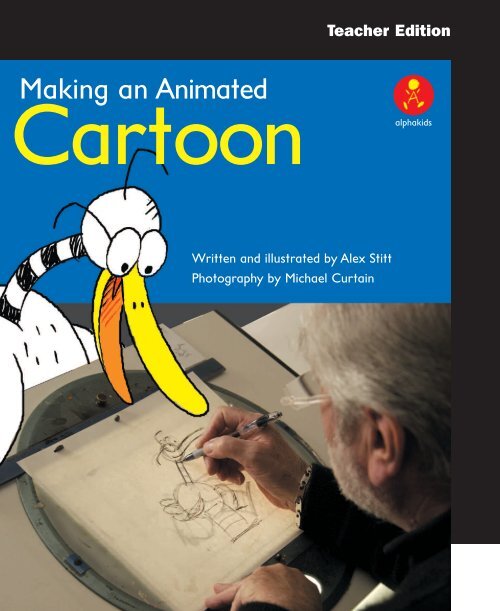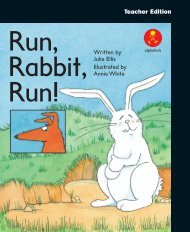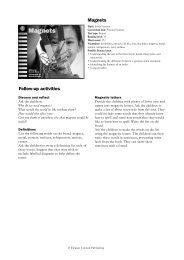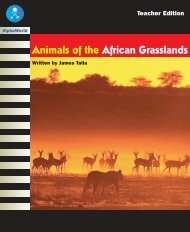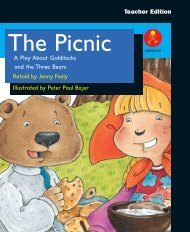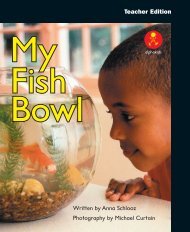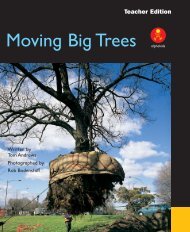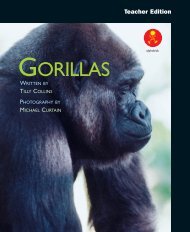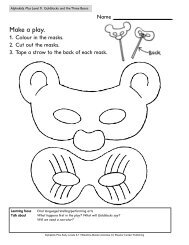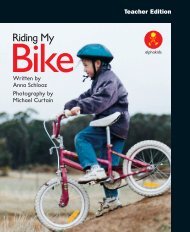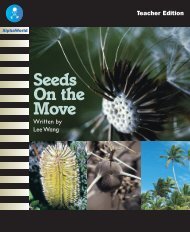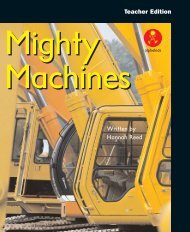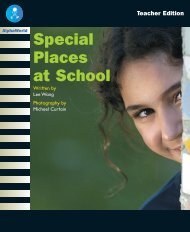Making an Animated Cartoon
Making an Animated Cartoon
Making an Animated Cartoon
Create successful ePaper yourself
Turn your PDF publications into a flip-book with our unique Google optimized e-Paper software.
Teacher Edition<br />
<strong>Making</strong> <strong>an</strong> <strong>Animated</strong><br />
<strong>Cartoon</strong><br />
alphakids<br />
Written <strong>an</strong>d illustrated by Alex Stitt<br />
Photography by Michael Curtain
Published edition<br />
© Ele<strong>an</strong>or Curtain<br />
Publishing 2004<br />
Text © Kerrie Sh<strong>an</strong>ah<strong>an</strong><br />
Photographs<br />
© Ele<strong>an</strong>or Curtain<br />
Publishing<br />
First published 2004<br />
Apart from <strong>an</strong>y fair dealing for<br />
the purposes of study, research,<br />
criticism or review, as<br />
permitted under the Copyright<br />
Act of Australia, no part of this<br />
book may be reproduced by<br />
<strong>an</strong>y process, or tr<strong>an</strong>smitted in<br />
<strong>an</strong>y form, without permission<br />
of the copyright owner. Where<br />
copies of part or the whole of<br />
this book are made under Part<br />
VB of the Copyright Act, the<br />
law requires that records of<br />
such copying be kept <strong>an</strong>d the<br />
copyright owner is entitled to<br />
claim payment.<br />
Developed by<br />
Ele<strong>an</strong>or Curtain Publishing<br />
Designed by<br />
Alex<strong>an</strong>der Stitt<br />
Production by<br />
Publishing Solutions<br />
Printed in China<br />
ISBN 0 7253 3293 X<br />
1 2 3 4 5 6 7 8 9<br />
04 05 06<br />
How to use this book<br />
The Alphakids Plus teacher<br />
editions support teachers as they<br />
guide children’s reading <strong>an</strong>d<br />
thinking during one or more guided<br />
reading sessions. Teachers c<strong>an</strong><br />
observe children as they read <strong>an</strong>d<br />
choose from the given suggestions<br />
to suit individual needs.<br />
Before reading<br />
Setting the context, front cover<br />
<strong>an</strong>d title page:<br />
The suggestions help teachers to<br />
set the scene <strong>an</strong>d prepare children<br />
for reading the book. Prompts help<br />
to determine children’s prior<br />
knowledge. Where necessary,<br />
background information is<br />
provided. Teachers are encouraged<br />
to check that children underst<strong>an</strong>d<br />
the vocabulary listed <strong>an</strong>d to discuss<br />
the me<strong>an</strong>ings <strong>an</strong>d/or the structures<br />
of these words. Previous experiences<br />
with similar text types may also be<br />
discussed.<br />
During reading<br />
Predict, Read, Reflect:<br />
Questions encourage children to<br />
engage with the text by making<br />
predictions. They then read a<br />
section of the text <strong>an</strong>d reflect on<br />
what they have read. The focus is<br />
on the content, l<strong>an</strong>guage <strong>an</strong>d text<br />
features of the book.<br />
Observe <strong>an</strong>d support:<br />
Prompts help teachers to focus on<br />
the strategies children use as they<br />
read. Teachers c<strong>an</strong> then select from<br />
<strong>an</strong>d adapt the suggestions according<br />
to the needs of the individual child.<br />
The suggestions aim to develop a<br />
child’s reading abilities.<br />
Interruptions to the child’s reading<br />
should be minimal.<br />
After reading<br />
A selection of reading <strong>an</strong>d writing<br />
activities:<br />
The last pages of the teacher edition<br />
provide follow-up activities <strong>an</strong>d<br />
include the assessment focus.<br />
Selected text features<br />
• Step by step drawings showing the<br />
movements of cartoon characters are<br />
provided<br />
• A storyboard is shown<br />
• Technical l<strong>an</strong>guage is used throughout:<br />
<strong>an</strong>imation, cels, storyboard<br />
• A flow chart of the process is provided<br />
Vocabulary<br />
actors, adventures, <strong>an</strong>imated, <strong>an</strong>imation,<br />
background, cartoon, cels, character,<br />
computer, drawing, drawing board, film,<br />
flipbooks, movement, movies,<br />
photographed, picture, recording,<br />
sc<strong>an</strong>ned, screen, sketch, soundtrack,<br />
sound effects, still images, stories,<br />
storyboard, studio, television, videotape
Setting the context<br />
Do you like to watch cartoons What do you like about them<br />
How are cartoons made<br />
You might like to supply the children with some cartoons to look at.<br />
<strong>Making</strong> <strong>an</strong> <strong>Animated</strong><br />
<strong>Cartoon</strong><br />
Written <strong>an</strong>d illustrated by Alex Stitt<br />
Photography by Michael Curtain<br />
alphakids<br />
<strong>Making</strong> <strong>an</strong><br />
<strong>Animated</strong><br />
<strong>Cartoon</strong><br />
Written <strong>an</strong>d illustrated by Alex Stitt<br />
Photography by Michael Curtain<br />
Front cover<br />
Read the title of the book to the children<br />
<strong>an</strong>d show the front cover.<br />
What do you think ‘<strong>an</strong>imated’ me<strong>an</strong>s<br />
What sort of information do you think you<br />
will find in this book<br />
Title page<br />
Read out the names of the author,<br />
illustrator <strong>an</strong>d photographer.<br />
Who do you think is in the photograph
<strong>Making</strong> <strong>an</strong> <strong>Animated</strong> <strong>Cartoon</strong> Pages 2–5<br />
Predict<br />
This is the contents page. How is a table of contents<br />
org<strong>an</strong>ised How does it help you read the book<br />
Read the headings listed in the contents.<br />
Look at the pictures <strong>an</strong>d photographs on pages 4 <strong>an</strong>d 5.<br />
What do you think the m<strong>an</strong> in the photograph is doing<br />
Have you seen this cartoon character before<br />
Read to the end of page 5.<br />
Reflect<br />
Why do you think these chapters are in this order<br />
What is the first thing that Alex does when he begins a<br />
cartoon Where on the page does it tell us this<br />
2<br />
Observe <strong>an</strong>d support<br />
C<strong>an</strong> the child recognise the purpose of the text<br />
C<strong>an</strong> the child support their underst<strong>an</strong>ding of the<br />
text with direct evidence from the page<br />
What is this book trying to teach us How do you<br />
know this<br />
Who is telling us about making <strong>an</strong>imated cartoons<br />
Where does it tell us this<br />
What is <strong>an</strong> <strong>an</strong>imated cartoon<br />
What is the name of the character has Alex created<br />
What steps does Alex take when he is drawing<br />
Sebasti<strong>an</strong> Where on the page did you find this out
Contents<br />
Thinking of a character 4<br />
Writing the story 6<br />
Recording the soundtrack 8<br />
Drawing the characters 10<br />
Drawing the background 12<br />
Drawings that seem to move 14<br />
Flowchart 16<br />
Thinking of a character<br />
My name is Alex. I make up cartoon<br />
characters <strong>an</strong>d write stories about them.<br />
Sometimes I make the stories into<br />
cartoons for television.<br />
<strong>Making</strong> a cartoon character walk <strong>an</strong>d<br />
talk is called ‘<strong>an</strong>imation’.<br />
Most cartoons are about the<br />
adventures of a funny character.<br />
One of my favourite characters is<br />
Sebasti<strong>an</strong>. I have drawn Sebasti<strong>an</strong><br />
for story books, but now I w<strong>an</strong>t to<br />
make him into a cartoon that c<strong>an</strong><br />
be shown on TV.<br />
4<br />
First I make a rough sketch of Sebasti<strong>an</strong>.<br />
The finished drawing goes over<br />
the rough sketch.<br />
Then I colour in the finished drawing.<br />
5<br />
3
<strong>Making</strong> <strong>an</strong> <strong>Animated</strong> <strong>Cartoon</strong> Pages 6–7<br />
Predict<br />
What do you think Alex is doing here<br />
What characters c<strong>an</strong> you see in Alex’s drawings<br />
What is the cartoon about<br />
Read pages 6 <strong>an</strong>d 7.<br />
Reflect<br />
What does Alex do before he starts drawing<br />
Why is it import<strong>an</strong>t for Alex to know what is going to<br />
happen in the story before he starts drawing<br />
What are the names of the characters in this storyboard<br />
4<br />
Observe <strong>an</strong>d support<br />
C<strong>an</strong> the child monitor their own reading <strong>an</strong>d self<br />
correct when required<br />
I noticed that you stopped reading when you made<br />
<strong>an</strong> error. How did you know that you had made <strong>an</strong><br />
error<br />
What do you check for What do you do to help you<br />
work out the correct word<br />
I noticed that you re-read the whole sentence when<br />
you corrected yourself. Why did you do that
Writing the story<br />
Before I start drawing, I have to think of a story.<br />
I work out what is going to happen to Sebasti<strong>an</strong><br />
in the cartoon.<br />
I have decided that in my cartoon story,<br />
Sebasti<strong>an</strong> <strong>an</strong>d his friend Storky will have a race.<br />
The cartoon will be called ‘Sebasti<strong>an</strong> Wins the Race’.<br />
Storky<br />
I draw a storyboard to show how the<br />
cartoon will work.<br />
A storyboard is like a comic strip.<br />
I draw rough pictures of each stage<br />
of the story.<br />
Under each picture, I write what is happening<br />
<strong>an</strong>d what the characters will say.<br />
6<br />
7<br />
5
<strong>Making</strong> <strong>an</strong> <strong>Animated</strong> <strong>Cartoon</strong> Pages 8–11<br />
Predict<br />
Look at the photos on pages 8 <strong>an</strong>d 9. What do you think<br />
these people might be doing<br />
Why are there people playing musical instruments<br />
Look at the drawings of Sebasti<strong>an</strong> on pages 10 <strong>an</strong>d 11.<br />
What is Sebasti<strong>an</strong> doing in these pictures<br />
Read to the end of page 11.<br />
Reflect<br />
What has happened so far in the making of this<br />
<strong>an</strong>imated cartoon<br />
What happens at the recording studio<br />
How does the <strong>an</strong>imation drawing board help Alex when<br />
he is drawing the characters<br />
6<br />
Observe <strong>an</strong>d support<br />
C<strong>an</strong> the child use contextual information to<br />
underst<strong>an</strong>d new vocabulary such as ‘recording<br />
studio’ <strong>an</strong>d ‘<strong>an</strong>imation drawing board’<br />
What is a recording studio What happens in a<br />
recording studio How do you know this<br />
What is a drawing <strong>an</strong>imation board Where in the<br />
text did it tell you this Where else on the page are<br />
we given information about drawing on <strong>an</strong> <strong>an</strong>imation<br />
drawing board
Recording the soundtrack<br />
Come on, Sebasti<strong>an</strong>!<br />
Once the story is finished, I go to a recording studio.<br />
At the studio, actors record the lines said by the<br />
characters. They make up funny voices to suit the<br />
characters.<br />
Music <strong>an</strong>d sound effects are recorded in the studio too.<br />
You might as well give up.<br />
You’ll never catch me!<br />
8<br />
9<br />
Drawing the characters<br />
Now it is time to start drawing.<br />
To make the cartoon come to life, I have to draw<br />
every single movement the characters make.<br />
I draw each movement on a separate sheet of<br />
paper. Later these rough drawings will be traced<br />
neatly onto sheets of clear plastic.<br />
I use <strong>an</strong> <strong>an</strong>imation drawing board to help me<br />
when I am drawing the characters.<br />
The top of the drawing board is made of glass.<br />
There is a light behind the glass.<br />
Here are some of my rough drawings of Sebasti<strong>an</strong> running.<br />
See if you c<strong>an</strong> follow his legs.<br />
I put the pictures on top of each other on the drawing<br />
board. Because I c<strong>an</strong> see through them, I c<strong>an</strong> check that<br />
the characters are the same size <strong>an</strong>d shape in each drawing.<br />
10<br />
In drawing number 1<br />
Sebasti<strong>an</strong>’s right heel is<br />
on the ground.<br />
By drawing number 6<br />
his left heel has hit the<br />
ground.<br />
By drawing<br />
number 11 his<br />
right heel is on<br />
the ground again!<br />
11<br />
7
<strong>Making</strong> <strong>an</strong> <strong>Animated</strong> <strong>Cartoon</strong> Pages 12–13<br />
Predict<br />
What is Alex drawing on<br />
How does this help Alex to make the cartoon<br />
What does the labelled diagram show us<br />
Read pages 12 <strong>an</strong>d 13.<br />
Reflect<br />
What is Alex doing in this step<br />
What does Alex draw the background on<br />
What about the characters<br />
What might the next step be<br />
Observe <strong>an</strong>d support<br />
C<strong>an</strong> the child read the text fluently<br />
Well done. You read the text very clearly. I could hear<br />
everything you were reading. This made it easy for<br />
me to underst<strong>an</strong>d the information.<br />
If the child is having difficulty you could model the<br />
reading of the text in a fluent m<strong>an</strong>ner.<br />
8
Drawing the<br />
background<br />
I also need to draw a<br />
background.<br />
The background shows<br />
where the story takes<br />
place.<br />
The characters<br />
are drawn on<br />
separate clear<br />
sheets called<br />
cels.<br />
I draw the background<br />
on a separate sheet of<br />
paper.<br />
When I have drawn the<br />
background, I put the<br />
pictures of the characters<br />
on top. The background<br />
c<strong>an</strong> be seen through the<br />
clear plastic.<br />
Background<br />
12<br />
Cels<br />
are laid on<br />
top of each<br />
other to<br />
create each<br />
scene.<br />
The background<br />
is placed under<br />
the cels.<br />
13<br />
9
<strong>Making</strong> <strong>an</strong> <strong>Animated</strong> <strong>Cartoon</strong> Pages 14–16<br />
Predict<br />
Why would Alex need to draw so m<strong>an</strong>y pictures of<br />
Sebasti<strong>an</strong> <strong>an</strong>d Storky<br />
What do you think the chart on page 16 shows<br />
Read to the end of page 16.<br />
Reflect<br />
How does Alex make it look like Sebasti<strong>an</strong> <strong>an</strong>d Storky are<br />
moving<br />
What happens to the finished drawings<br />
C<strong>an</strong> you explain what the chart tells us<br />
10<br />
Observe <strong>an</strong>d support<br />
C<strong>an</strong> the child use their knowledge of phonics to<br />
decode difficult words such as ‘photographed’<br />
Point out the word ‘photographed’.<br />
How did you know this said ‘photographed’ What<br />
did you check<br />
At the point of need you might say: Look at the first<br />
two letters. What sound do they make when they are<br />
together C<strong>an</strong> you see these letters <strong>an</strong>ywhere else in<br />
the word<br />
Check the ending of the word. C<strong>an</strong> you break the<br />
word up What would make sense here
Drawings that seem<br />
to move<br />
When different still images are<br />
shown very quickly, one after the<br />
other, they look as if they are<br />
moving.<br />
<strong>Cartoon</strong>s, movies, TV <strong>an</strong>d<br />
flipbooks all use this trick to make<br />
us think that the pictures they<br />
show are moving.<br />
These are finished<br />
drawings of Sebasti<strong>an</strong><br />
<strong>an</strong>d Storky.<br />
When they are shown<br />
quickly, one after the<br />
other, they will look<br />
as if they are moving.<br />
14<br />
Animation drawings used to be photographed on movie<br />
film, but now they are usually sc<strong>an</strong>ned into a computer<br />
<strong>an</strong>d then put on film or<br />
videotape.<br />
Then they are shown<br />
quickly, one after the<br />
other... <strong>an</strong>d Sebasti<strong>an</strong> <strong>an</strong>d<br />
Storky look as if they are<br />
running across your TV<br />
screen!<br />
15<br />
Flow Chart<br />
character<br />
story<br />
storyboard<br />
soundtrack<br />
characters<br />
background<br />
sc<strong>an</strong> or photograph the drawings<br />
watch Sebasti<strong>an</strong> win the race!<br />
16<br />
11
After reading<br />
Being a me<strong>an</strong>ing maker<br />
Encourage the children to support<br />
their <strong>an</strong>swers with evidence from<br />
the book as they discuss these<br />
questions:<br />
What is <strong>an</strong> <strong>an</strong>imated cartoon<br />
What things need to happen to<br />
make <strong>an</strong> <strong>an</strong>imated cartoon<br />
How are still pictures made to look<br />
as if they are moving<br />
Being a code breaker<br />
Children may like to explore the<br />
following l<strong>an</strong>guage feature:<br />
• the sound /c/: cartoon, character,<br />
make, walk, called, c<strong>an</strong>, think,<br />
work, Storky, comic, pictures,<br />
recording, actors, music, come,<br />
clear, plastic, background, takes,<br />
trick, computer<br />
Being a text user<br />
What information is contained in<br />
the words<br />
What information is in the<br />
illustrations <strong>an</strong>d photographs<br />
What information is found in the<br />
captions<br />
Would this book work without<br />
illustrations <strong>an</strong>d photographs Why<br />
What did you learn by reading this<br />
book<br />
Being a text critic<br />
Is this the way all <strong>an</strong>imated<br />
cartoons are made How could you<br />
find out<br />
12
Responding to text<br />
Children could make their<br />
own comic story <strong>an</strong>d then<br />
present it as a storyboard. Encourage<br />
the children to use the text as a<br />
reference, particularly pages 6 <strong>an</strong>d 7.<br />
Have children think of their<br />
own character that could be<br />
used in <strong>an</strong>imated cartoons. They<br />
could draw the character <strong>an</strong>d write<br />
a description of what the character<br />
is like.<br />
Have children look through<br />
the book <strong>an</strong>d write a list of<br />
all the words associated with<br />
making <strong>an</strong> <strong>an</strong>imated cartoon.<br />
Children could then quiz each<br />
other on the me<strong>an</strong>ings of these<br />
words.<br />
Writing links<br />
Shared writing<br />
Have children work together in<br />
small groups to list, in order, the<br />
steps involved in making <strong>an</strong><br />
<strong>an</strong>imated cartoon. They could write<br />
a short description outlining each<br />
step. Encourage the children to use<br />
labelled diagrams to help explain<br />
their writing.<br />
Independent writing<br />
Children could read other stories<br />
about Sebasti<strong>an</strong> from the Alphakids<br />
series. These are: ‘Sebasti<strong>an</strong>’<br />
(level 9), ‘Sebasti<strong>an</strong> gets the<br />
Hiccups’ (level 13), ‘Sebasti<strong>an</strong>’s<br />
Special Present’ (level 15),<br />
‘Sebasti<strong>an</strong> Tidies Up’ (level 18),<br />
‘The Great Sebasti<strong>an</strong>’ (level 19).<br />
They could also read the following<br />
Alphakids Plus books: ‘Sebasti<strong>an</strong><br />
Learns to Fly’ (level 5), ‘Sebasti<strong>an</strong>’s<br />
New Sister’ (level 10).<br />
The children could then write <strong>an</strong>d<br />
illustrate their own Sebasti<strong>an</strong> story.<br />
Possible assessment focus<br />
C<strong>an</strong> the child:<br />
• use the information in the illustrations to explain how Alex makes<br />
Sebasti<strong>an</strong> walk in <strong>an</strong> <strong>an</strong>imated cartoon<br />
• apply knowledge from the book to present their own story as a<br />
storyboard<br />
whole text activity sentence activity word activity
alphakids<br />
alphakids<br />
alphakids<br />
alphakids<br />
alphakids<br />
alphakidss<br />
<strong>Making</strong> <strong>an</strong> <strong>Animated</strong><br />
<strong>Cartoon</strong><br />
Written <strong>an</strong>d illustrated by Alex Stitt<br />
Photography by Michael Curtain<br />
Teacher<br />
Edition<br />
Other<br />
books<br />
at this<br />
level<br />
The<br />
Runaway<br />
Nose<br />
Written by Christopher Stitt<br />
Illustrated by Alex Stitt<br />
Topic: <strong>Cartoon</strong>s<br />
Curriculum link: Art, Technology<br />
Text type: Expl<strong>an</strong>ation<br />
Reading level: 23<br />
Word count: 455<br />
Vocabulary: actors, adventures, <strong>an</strong>imated,<br />
<strong>an</strong>imation, background, cartoon, cels, character,<br />
computer, drawing, drawing board, film, flipbooks,<br />
movement, movies, photographed, picture,<br />
recording, sc<strong>an</strong>ned, screen, sketch, soundtrack,<br />
sound effects, still images, stories, storyboard,<br />
studio, television, videotape<br />
The<br />
Rare<br />
Bird<br />
Retold by Clare Bradford<br />
Illustrated by Naomi Lewis<br />
Good toEat<br />
Written by Jenny Feely Illustrations by Alex Stitt<br />
Turtles<br />
in<br />
Trouble<br />
Written by Sara Oldfield<br />
Great Big Eleph<strong>an</strong>ts<br />
Written by Rosa Müller<br />
Possible literacy focus<br />
Underst<strong>an</strong>ding information presented in step by<br />
step illustrations.<br />
Applying information presented in the text, such as<br />
how to make a storyboard<br />
Summary<br />
This book explains the process of making <strong>an</strong><br />
<strong>an</strong>imated cartoon. The text is written from the point<br />
of view of <strong>an</strong>imator Alex Stitt.<br />
ISBN 0- 7253- 3293- X<br />
9 780725 332938<br />
alphakids


